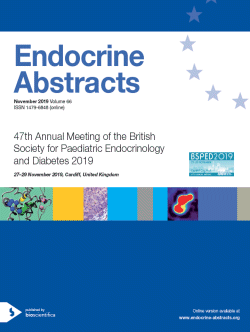
47th Meeting of the British Society for Paediatric Endocrinology and Diabetes
Cardiff,
UK
27 Nov 2019 - 29 Nov 2019

Poster Presentations
Learning from Mistakes and Miscellaneous
ea0066p63 | Learning from Mistakes and Miscellaneous | BSPED2019
The use of ‘Hypopaks’ in the investigation of hypoglycaemia in children
Beckett Rachel , Spence Kirsty , Hamilton Gillian , Alcheikh Mohammad , O'Sullivan Siobhan , Connolly Grainne , McDonnell Margaret , Abid Noina , Heffernan Emmeline
ea0066p64 | Learning from Mistakes and Miscellaneous | BSPED2019
‘Cognitive Bias – One of many’
Oyibo Iyabo , Jain Shika , D'Souza Nirupa
ea0066p65 | Learning from Mistakes and Miscellaneous | BSPED2019
Perplexing presentation of hypoglycemia
ea0066p66 | Learning from Mistakes and Miscellaneous | BSPED2019
β-carotenaemia with secondary amenorrhea in a teenage athlete
Thurston Victoria , Calvert Jennifer , Sachdev Pooja
ea0066p67 | Learning from Mistakes and Miscellaneous | BSPED2019
Using CRISPR/Cas9 gene editing to study the molecular mechanisms of congenital hyperinsulinism (CHI)
Purushothaman Preetha , Walker Amy , Maeshima Ruhina , Attwood Martin , Hussain Khalid , Hart Stephen
ea0066p68 | Learning from Mistakes and Miscellaneous | BSPED2019
Mitochondrial disorders and endocrine dysfunction
Venkataramakrishnan Ramya , Barton John
ea0066p69 | Learning from Mistakes and Miscellaneous | BSPED2019
Improving the patient journey in the children and young people diabetes clinics of the Cardiff and Vale Health Board
ea0066p70 | Learning from Mistakes and Miscellaneous | BSPED2019
Audit of annual review investigations for girls with Turner’s syndrome against the Turner’s syndrome support society checklist
ea0066p71 | Learning from Mistakes and Miscellaneous | BSPED2019
Intracranial hypertension secondary to severe obesity: case series
Apperley Louise , Erlandson-Parry Karen , Laing Peter , Das Urmi , Senniappan Senthil



